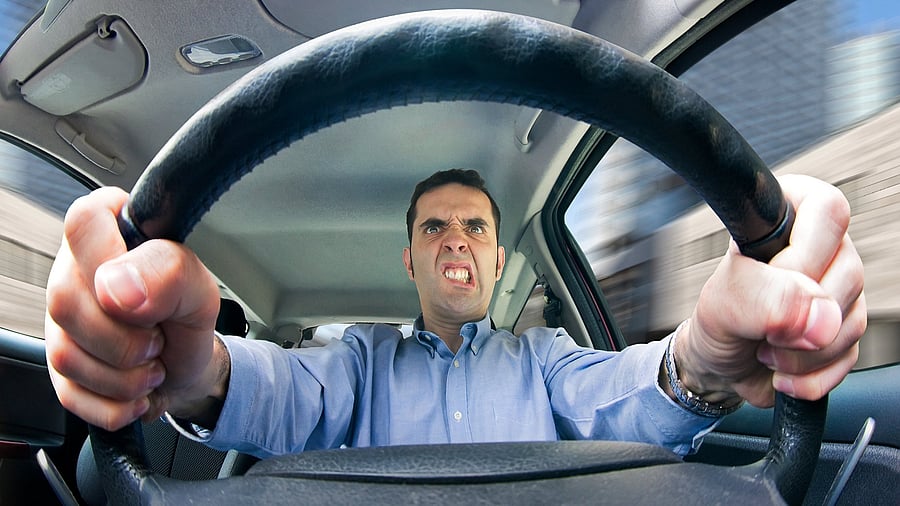
Representative image for road rage.
iStock Photo
Bengaluru’s traffic congestion has now become cliché. In July, the city saw congestion reach an all-time high, with the total length of traffic jams stretching over 36,000 km, reducing average vehicle speeds from 20.6 kmph in January to a sluggish 18.6 kmph by August. Adding to this stressful situation is the disturbing rise in road rage incidents.
Road rage has become an everyday occurrence, as growing traffic congestion, lengthy commutes, and mounting stress prompt drivers to act out aggressively. Common behaviours include excessive honking, tailgating, dangerous overtaking, verbal abuse, and hostile gestures. These actions are often exacerbated when the target is a woman driver. Many instances go unreported, creating a culture of aggression that erodes civility and safety on the roads.
Contributing to this hostile environment are structural inequalities, societal prejudices, and a general lack of driving etiquette. In India, personal safety often takes a backseat, with laws requiring seatbelts and helmets needing stricter enforcement. Drivers frequently ignore traffic rules, compete for space, and flout signals, adding to the frustration on the roads.
In 2024 alone, police in Bengaluru district have registered 40 cases. Of these, three have escalated into murder cases, while three more have been classified as attempts to murder. Additionally, several cases have involved grievous hurt, simple hurt, and criminal intimidation, highlighting the serious and often violent outcomes of road rage confrontations.
In response to these alarming trends, local police stations are increasingly resorting to opening rowdy-sheeter cases against repeat offenders to deter future aggressive behaviour and strengthen law enforcement’s ability to monitor and respond to high-risk individuals. These statistics underscore the growing severity of road rage in the city and the urgent need for curbing this dangerous trend.
Two recent incidents illustrate the seriousness of this issue:
In Nelamangala, a sand dealer and tipper driver stopped for dinner at a dhaba along NH-75. A dispute with an SUV driver quickly escalated from an argument to a violent attack. The SUV driver assaulted the sand dealer with a jack rod, causing severe head injuries.
Although the victim received medical attention, he succumbed to his injuries the next day. The initial case of simple hurt was reclassified as murder, and the main accused, along with two accomplices, was arrested.
In Hebbagodi, an SUV driver attempted to overtake a school bus in peak hour traffic but was unable to due to congestion. In retaliation, five individuals from the SUV stopped the bus, verbally abused the driver, and physically assaulted him in front of the terrified schoolchildren. This incident has raised serious concerns about the safety of school transportation and the increasing incidence of road rage. The attackers were arrested and now face charges of assault and endangering minors.
The escalation of road rage incidents has placed immense strain on police resources, making it a growing priority for law enforcement. Not only do these incidents threaten public safety, but they also underscore the need for stricter road regulations and heightened safety measures.
To address the growing road rage, a multi-faceted approach is necessary. Some suggested measures include:
Deploy specialised teams trained in conflict resolution and de-escalation techniques to handle road rage incidents, particularly during rush hours.
Use motorcycle units to quickly navigate through congested areas and respond to road rage incidents.
Equip traffic police with body cameras to capture incidents in real-time, ensuring accountability and enabling immediate response.
Incorporate driving etiquette and road rage prevention into the driving license training process, ensuring that new drivers are educated on the consequences of aggressive driving.
Launch campaigns in high-traffic areas, using radio stations, social media, and influencers to broadcast calming messages during peak traffic hours and encourage patience among drivers.
Partner with corporate offices in traffic-dense zones to offer workshops on safe driving practices and anger management.
Implement adaptive traffic signals that adjust based on congestion levels to improve traffic flow and reduce frustration.
Introduce hefty fines, points on licenses, and immediate penalties for drivers involved in road rage incidents to deter aggressive behaviour.
Encourage drivers to install dashcams and submit footage of road rage incidents to the police. Create anonymous reporting options for witnesses to aid in tracking violators.
Cancel licenses of repeat offenders and mandate community engagement projects for those involved in minor road rage incidents.
Consider entering repeat offenders into a rowdy sheeter registry to deter further aggressive behaviour.
(The writer is the Superintendent of Police, Bengaluru)